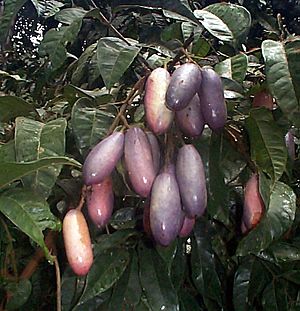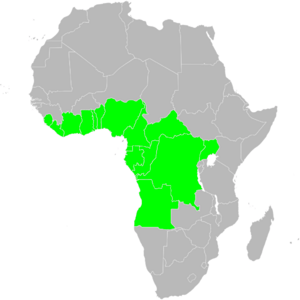Dacryodes edulis facts for kids
Quick facts for kids Dacryodes edulis |
|
|---|---|
 |
|
| Scientific classification | |
| Genus: |
Dacryodes
|
| Species: |
edulis
|
 |
|
| Native distribution of the Safou | |
| Synonyms | |
|
|
Dacryodes edulis is a fruit tree that grows naturally in Africa. It has many common names, like safou in countries such as the Republic of the Congo and Angola. People also call it plum in Cameroon, atanga in Equatorial Guinea, and ube in Nigeria. Other names include African pear, bush pear, and bush butter tree.
Contents
What it Looks Like
Dacryodes edulis is an evergreen tree, meaning it keeps its leaves all year round. In forests, it can grow very tall, sometimes up to 40 meters (about 130 feet). But when planted on farms, it usually stays shorter, around 12 meters (about 40 feet).
The tree has a short trunk and a thick, full top part called a crown. Its bark is light gray and rough, often with sticky resin droplets. The leaves are made up of 5 to 8 pairs of smaller leaflets, and their top surface is shiny.
The flowers are yellow and small, about 5 mm across. They grow in large groups. The fruit is shaped like an oval and can be 4 to 12 cm long. The skin of the fruit is dark blue or purple, while the inside flesh is light green. The tree usually flowers when the rainy season begins and produces fruit for 2 to 5 months afterward.
There are two main types of Dacryodes edulis:
- D. e. var. edulis: This type has larger fruits and strong, upward-growing branches.
- D. e. var. parvicarpa: This type has smaller fruits and thin, hanging branches.
Where it Grows
The Dacryodes edulis tree, also known as Safou, prefers to grow in shady, wet tropical forests. However, it can also grow well in different types of soil, and it adapts to various levels of humidity, temperature, and day length.
Naturally, you can find this tree from Angola in the south, all the way to Nigeria and Sierra Leone in the west, and Uganda in the east. It is also grown in Malaysia.
How People Use It
The Dacryodes edulis tree is very useful. It can help improve what people eat, make sure there's enough food, help rural areas grow, and support good land care.
The Fruit
The most common use for D. edulis is its fruit. You can eat it raw, cook it in salty water, or roast it. When cooked, the fruit's flesh feels a bit like butter and is often eaten on bread.
The fruit pulp has a lot of oil, about 48%. A farm with these trees can produce 7 to 8 tons of oil per hectare (about 2.5 acres). This fruit has much more fat than fruits like apples or guavas. It is also full of vitamins.
The kernel (the seed inside) can be used to feed animals like sheep or goats. The flowers are also good for bees.
The Wood
The wood of D. edulis is flexible and ranges in color from grayish-white to pink. It is often used for making tool handles and sometimes for mortars (bowls for grinding). It is also suitable for general carpentry work.
The Seed
The seed of Dacryodes edulis is rich in good things like carbohydrates, proteins, and fiber. It also has important minerals such as potassium, calcium, magnesium, and phosphorus. The seed contains healthy fats like palmitic, oleic, and linoleic acids. Scientists have found that the seed has properties that could be useful for different industries.
Medicinal Uses
This tree is also a source for many herbal medicines. For a long time, people in some African countries have used it in traditional medicine. They use it to help with things like wounds, skin problems, dysentery (a type of stomach illness), and fever. Studies have shown that parts of the plant can help fight germs and act as antioxidants, which protect your body's cells.
Other Uses
The sticky resin from the tree is sometimes burned for light or used as a glue. The tree is also planted as an ornamental plant because it looks nice. It is known to help improve soil quality by adding a lot of plant material back into the ground.
About the Name
The name of the genus, Dacryodes, comes from the Greek word dakruon, which means "tear." This refers to the small drops of resin that look like tears on the bark of these trees. The species name edulis means "edible," which tells us the fruit can be eaten.
See also
 In Spanish: Dacryodes edulis para niños
In Spanish: Dacryodes edulis para niños

